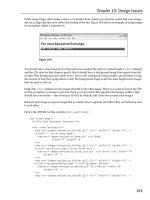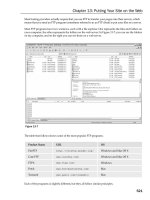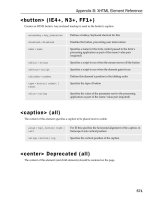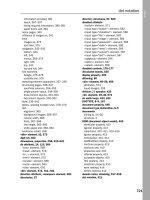- Trang chủ >>
- Khoa Học Tự Nhiên >>
- Vật lý
Waves and oscillations, second edition 2010 8532
Bạn đang xem bản rút gọn của tài liệu. Xem và tải ngay bản đầy đủ của tài liệu tại đây (2.41 MB, 394 trang )
Waves and
Oscillations
This page
intentionally left
blank
Waves and
Oscillations
(SECOND EDITION)
R.N. Chaudhuri
Ph.D.
Former Professor and Head
Department of Physics, Visva-Bharati
Santiniketan, West Bengal
Copyright © 2010, 2001, New Age International (P) Ltd., Publishers
Published by New Age International (P) Ltd., Publishers
All rights reserved.
No part of this ebook may be reproduced in any form, by photostat, microfilm, xerography,
or any other means, or incorporated into any information retrieval system, electronic or
mechanical, without the written permission of the publisher. All inquiries should be
emailed to
ISBN (13) : 978-81-224-2842-1
PUBLISHING FOR ONE WORLD
NEW AGE INTERNATIONAL (P) LIMITED, PUBLISHERS
4835/24, Ansari Road, Daryaganj, New Delhi - 110002
Visit us at www.newagepublishers.com
Foreword
In order to understand the physical world around us, it is absolutely necessary to know the
basic features of Physics. One or the other principle of Physics is at work in objects of daily
use, e.g., a ceiling fan, a television set, a bicycle, a computer, and so on. In order to understand
Physics, it is necessary to solve problems. The exercise of solving problems is of immense
help in mastering the fundamentals of the subject. Keeping this in mind, we have undertaken
a project to publish a series of books under the broad title Basic Physics Through Problems.
The series is designed to meet the requirements of the undergraduate students of colleges
and universities, not only in India but also in the rest of the third world countries.
Each volume in the series deals with a particular branch of Physics, and contains about
300 problems with step-by-step solutions. In each book, a chapter begins, with basic definitions,
principles, theorems and results. It is hoped that the books in this series will serve two main
purposes: (i) to explain and derive in a precise and concise manner the basic laws and
formulae, and (ii) to stimulate the reader in solving both analytical and numerical problems.
Further, each volume in the series is so designed that it can be used either as a supplement
to the current standard textbooks or as a complete text for examination purposes.
Professor R. N. Chaudhuri, the author of the present volume in the series, is a teacher
of long standing. He has done an excellent job in his selection of the problems and in deriving
the solutions to these problems.
Kiran C. Gupta
Professor of Physics
Visva-Bharati
Santiniketan
This page
intentionally left
blank
Preface to the Second Edition
It is a great pleasure for me to present the second edition of the book after the warm
response of the first edition. There are always important new applications and examples on
Waves and Oscillations. I have included many new problems and topics in the present
edition. It is hoped that the present edition will be more useful and enjoyable to the students.
I am very thankful to New Age International (P) Ltd., Publishers for their untiring
effort to bringing out the book within a short period with a nice get up.
R.N. Chaudhuri
This page
intentionally left
blank
Preface to the First Edition
The purpose of this book is to present a comprehensive study of waves and oscillations in
different fields of Physics. The book explains the basic concepts of waves and oscillations
through the method of solving problems and it is designed to be used as a textbook for a
formal course on the subject. Each chapter begins with the short but clear description of the
basic concepts and principles. This is followed by a large number of solved problems of
different types. The proofs of relevant theorems and derivations of basic equations are included
among the solved problems. A large number of supplementary problems at the end of each
chapter serves as a complete review of the theory. Hints are also provided in the case of
relatively complex problems.
The topics discussed include simple harmonic motion, superposition principle and coupled
oscillations, damped harmonic oscillations, forced vibrations and resonance, waves,
superposition of waves, Fourier analysis, vibrations of strings and membranes, Doppler
effect, acoustics of buildings, electromagnetic waves, interference and diffraction. In all, 323
solved and 350 supplementary problems with answers are given in the book.
This book will be of great help not only to B.Sc. (Honours and Pass) students of Physics,
but also to those preparing for various competitive examinations.
I thank Professor K.C. Gupta for going through the manuscripts carefully and for
suggesting some new problems for making the book more interesting and stimulating.
R.N. Chaudhuri
This page
intentionally left
blank
Contents
Foreword
Preface to the Second Edition
Preface to the First Edition
v
vii
ix
1. Simple Harmonic Motion
1.1
1.2
1.3
1.4
1.5
1.6
1.7
1.8
1.9
1.10
1–57
Periodic Motion 1
The Time Period (T) 1
The Frequency (ν) 1
The Displacement (X or Y ) 1
Restoring Force or Return Force 1
Simple Harmonic Motion (SHM) 2
Velocity, Acceleration and Energy of a Simple Harmonic Oscillator 2
Reference Circle 3
The Simple Pendulum 4
Angular Simple Harmonic Motion (Torsional Pendulum) 4
Solved Problems 5
Supplementary Problems 50
2. Superposition Principle and Coupled Oscillations
2.1
2.2
2.3
2.4
2.5
Degrees of Freedom 58
Superposition Principle 58
Superposition Principle for Linear Inhomogeneous Equation 58
Superposition of Simple Harmonic Motions along a Straight Line 58
Superposition of Two Simple Harmonic Motions at Right Angles to
Each Other 59
Solved Problems 59
Supplementary Problems 84
xi
58–88
xii
CONTENTS
3. The Damped Harmonic Oscillator
3.1
3.2
Damped Harmonic Motion 89
Damped LC Oscillations (LCR Circuit) 89
Solved Problems 90
Supplementary Problems 103
4. Forced Vibrations and Resonance
4.1
4.2
4.3
4.4
124–152
Waves 124
Waves in One Dimension 124
Three Dimensional Wave Equation 126
Transverse Waves on a Stretched String 126
Stroboscope or Strobe 126
Solved Problems 127
Supplementary Problems 148
6. Superposition of Waves
6.1
6.2
6.3
6.4
153–176
Superposition Principle 153
Stationary Waves 153
Wave Reflection 153
Phase Velocity and Group Velocity 154
Solved Problems 155
Supplementary Problems 173
7. Fourier Analysis
7.1
7.2
7.3
7.4
7.5
7.6
7.7
105–123
Forced Vibrations 105
Resonance 106
Quality Factor Q 106
Helmholtz Resonator 106
Solved Problems 107
Supplementary Problems 121
5. Waves
5.1
5.2
5.3
5.4
5.5
89–104
177–203
Fourier’s Theorem 177
Dirichlet’s Condition of Convergence of Fourier Series 177
Fourier Cosine Series 178
Fourier Sine Series 178
Representation of a Function by Fourier Series in the Range a ≤ x ≤ b 178
Fourier Integral Theorem 179
Fourier Transform 180
xiii
CONTENTS
7.8
7.9
Fourier Cosine Transform 180
Fourier Sine Transform 180
Solved Problems 180
Supplementary Problems 199
8. Vibrations of Strings and Membranes
8.1
8.2
8.3
8.4
8.5
Transverse Vibration of a String Fixed at Two Ends 204
Plucked String 204
Struck String 204
Bowed String 204
Transverse Vibration of Membranes 205
Solved Problems 205
Supplementary Problems 236
9. The Doppler Effect
9.1
268–289
Maxwell’s Equations 268
Propagation of Plane Electromagnetic Waves in Matter 268
Energy Flow and Poynting Vector 269
Radiation Pressure 270
Polarization of Electromagnetic Wave 270
Solved Problems 270
Supplementary Problems 287
12. Interference
12.1
12.2
258–267
Reverberation 258
Time of Reverberation 258
Sabine’s Law 258
Decibel (dB) Unit of Sound Level 258
Solved Problems 259
Supplementary Problems 266
11. Electromagnetic Waves
11.1
11.2
11.3
11.4
11.5
241–257
Doppler Shift 241
Solved Problems 242
Supplementary Problems 256
10. Acoustics of Buildings
10.1
10.2
10.3
10.4
204–240
Young’s Experiment 290
Displacement of Fringes due to Interposition of Thin Film 290
290–332
xiv
CONTENTS
12.3
12.4
12.5
12.6
12.7
Fresnel’s Biprism 291
Change of Phase due to Reflection 291
Llyod’s Mirror 291
Thin-Film Interference 291
The Michelson Interferometer 291
Solved Problems 291
Supplementary Problems 326
13. Diffraction
13.1
13.2
13.3
13.4
13.5
13.6
13.7
13.8
333–364
Diffraction 333
Single-Slit Diffraction 333
Diffraction by a Circular Aperture 333
Rayleigh Criterion 334
Double-Slit Diffraction 334
Multiple-Slit Diffraction 334
Diffraction Grating 334
X-ray Diffraction 335
Solved Problems 335
Supplementary Problems 360
Answers to Supplementary Problems
365–373
Index
375–379
1
Simple Harmonic Motion
1.1 PERIODIC MOTION
When a body repeats its path of motion back and forth about the equilibrium or mean
position, the motion is said to be periodic. All periodic motions need not be back and forth
like the motion of the earth about the sun, which is periodic but not vibratory in nature.
1.2 THE TIME PERIOD (T)
The time period of a vibrating or oscillatory system is the time required to complete one full
cycle of vibration of oscillation.
ν)
1.3 THE FREQUENCY (ν
The frequency is the number of complete oscillations or cycles per unit time. If T is the time
for one complete oscillation.
ν =
1
T
...(1.1)
1.4 THE DISPLACEMENT (X OR Y )
The displacement of a vibrating body is the distance from its equilibrium or mean position.
The maximum displacement is called the amplitude.
a0
1.5 RESTORING FORCE OR RETURN FORCE
The mass m lies on a frictionless horizontal surface. It is
connected to one end of a spring of negligible mass and
relaxed length a0, whose other end is fixed to a rigid wall
W [Fig. 1.1 (a)].
If the mass m is given a displacement along the x-axis
and released [Fig. 1.1 (b)], it will oscillate back and forth in
a straight line along x-axis about the equilibrium position
O. Suppose at any instant of time the displacement of the
mass is x from the equilibrium position. There is a force
W
m
x
O
(a)
x
a0
W
m
O
(b)
Fig 1.1
x
2
WAVES AND OSCILLATIONS
tending to restore m to its equilibrium position. This force, called the restoring force or return
force, is proportional to the displacement x when x is not large:
^
...(1.2)
F = –k x i
where k, the constant of proportionality, is called the spring constant or stiffness factor, and
^
i is the unit vector in the positive x-direction. The minus sign indicates that the restoring
force is always opposite in direction to the displacement.
By Newton’s second law Eqn. (1.2) can be written as
x = –kx or, &&
x + ω2x = 0
m &&
...(1.3)
where
= k/m = return force per unit displacement per unit mass. ω is called the angular
frequency of oscillation.
ω2
1.6 SIMPLE HARMONIC MOTION (SHM)
If the restoring force of a vibrating or oscillatory system is proportional to the displacement
of the body from its equilibrium position and is directed opposite to the direction of displacement, the motion of the system is simple harmonic and it is given by Eqn. (1.3). Let the initial
conditions be x = A and x& = 0 at t = 0, then integrating Eqn. (1.3), we get
x(t) = A cos ωt
...(1.4)
where A, the maximum value of the displacement, is called the amplitude of the motion. If
T is the time for one complete oscillation, then
x(t + T) = x(t)
or
or
A cos ω(t + T) = A cos ωt
ωT = 2π
or
T =
2π
m
= 2π
ω
k
and
ν =
1
ω
=
T
2π
or,
...(1.5)
ω = 2πν.
The general solution of Eqn. (1.3) is
x(t) = C cos ωt + D sin ωt
...(1.6)
where C and D are determined from the initial conditions. Euqation (1.6) can be written as
x(t) = A cos (ωt – φ)
...(1.7)
where C = A cos φ and D = A sin φ. The amplitude for the motion described by Eqn. (1.7)
is now A = (C2 + D2)1/2 and the angular frequency is ω which is uneffected by the
initial conditions. The angle φ called the phase angle or phase constant or epoch is given by
φ = tan–1 (D/C), where φ is chosen in the interval 0 ≤ φ ≤ 2π.
1.7 VELOCITY, ACCELERATION AND ENERGY OF A SIMPLE HARMONIC
OSCILLATOR
From Eqn. (1.7), we find that the magnitude of the velocity v is
v = |–A ω sin(ωt – φ)| = Aω(1 – x2/A2)1/2
or
v = ω(A2 – x2)1/2
...(1.8)
3
SIMPLE HARMONIC MOTION
and the acceleration of the particle is
x = – Aω2 cos(ωt – φ) = –ω2x
a = &&
...(1.9)
We see that, in simple harmonic motion, the acceleration is proportional to the displacement but opposite in sign.
If T is the kinetic energy, V the potential energy, then from the law of conservation of
energy, in the absence of any friction-type losses, we have
E = T + V = constant
where E is the total energy of the oscillator.
Also, Force
F = –∇ V
dV
−
= –kx
dx
1 2
V =
kx + c
2
1
mω2A2cos2(ωt – φ) + c
V =
2
or
or
or
...(1.10)
where c is an arbitrary constant.
The kinetic energy of the oscillator is
T =
1 ·2
1
mx =
mω2A2 sin2(ωt – φ)
2
2
...(1.11)
1
mω2A2
2
...(1.12)
If V = 0 when x = 0, then c = 0 and
E =
(i) At the end points x = ± A,
The velocity of the particle v = 0,
Acceleration
a = ω2A directed towards the mean position,
kinetic energy T = 0
1
mω2A2 = E
2
(ii) At the mid-point (x = 0),
potential energy V =
v = ωA, a = 0, T =
(iii) At x = ± A
1
mω2A2 = E, V = 0
2
2, T = V =E/2.
1.8 REFERENCE CIRCLE
Suppose that the point Q is moving anticlockwise with uniform angular velocity ω along a
circular path with O as the centre (Fig. 1.2). This circle is called the reference circle for
simple harmonic motion. BOB′ is any diameter of the circle. B′OB is chosen to be along the
x-axis. From Q, a perpendicular QP is dropped on the diameter B′B. When Q moves with
uniform angular velocity along the circular path, the point P executes simple harmonic
motion along the diameter BB′. The amplitude of the back and forth motion of the point P
4
WAVES AND OSCILLATIONS
about the centre O is OB = the radius of the circle = A. Suppose Q is at B at time t = 0 and
it takes a time t for going from B to Q and by this time the point P moves form B to P. If
∠ QOB = θ, t = θ/ω or, θ = ωt, and x = OP = OQ cos θ = A cos ωt.
y
Q
A
θ
B′
O
x
P
x
B
Fig. 1.2
When Q completes one revolution along the circular path, the point P executes one complete
oscillation. The time period of oscillation T = 2π/ω. If we choose the circle in the xy plane,
the position of Q at any time t is given by
^
^
r = A cos ωt i + A sin ωt j .
1.9 THE SIMPLE PENDULUM
The bob of the simple pendulum undergoes nearly SHM if its angle of swing is not large. The
time period of oscillation of a simple pendulum of length l is given by
T = 2π l g
...(1.13)
where g is the acceleration due to gravity.
1.10 ANGULAR SIMPLE HARMONIC MOTION (TORSIONAL PENDULUM)
A disc is suspended by a wire. If we twist the disc from its rest position and release it, it will
oscillate about that position in angular simple harmonic motion. Twisting the disc through
an angle θ in either direction, introduces a restoring torque
Γ = – Cθ
…(1.14)
and the period of angular simple harmonic oscillator or torsional pendulum is given by
T = 2π I C
…(1.15)
where I is the rotational inertia of the oscillating disc about the axis of rotation and C is the
restoring torque per unit angle of twist.
5
SIMPLE HARMONIC MOTION
SOL
VED PR
OBLEMS
SOLVED
PROBLEMS
1. A point is executing SHM with a period πs. When it is passing through the centre of
its path, its velocity is 0.1 m/s. What is its velocity when it is at a distance of 0.03 m from
the mean position?
Solution
When the point is at a distance x from the mean position its velocity is given by
Eqn. (1.8):
v = ω(A2 – x2)1/2.
Its time period, T = 2π/ω = π; thus ω = 2 s–1. At x = 0, v = Aω = 0.1; thus A = 0.05 m.
When x = 0.03 m, v = 2 [(0.05)2 – (0.03)2]1/2 = 0.08 m/s.
2. A point moves with simple harmonic motion whose period is 4 s. If it starts from rest
at a distance 4.0 cm from the centre of its path, find the time that elapses before it has
described 2 cm and the velocity it has then acquired. How long will the point take to reach
the centre of its path?
Solution
Amplitude A = 4 cm and time period T = 2π/ω = 4 s. The distance from the centre of
the path x = 4–2 = 2 cm. Since x = A cos ωt, we have 2 = 4 cos ωt. Hence t = 2/3 s and the
velocity v = ω
A2 − x 2 = π/2 4 2 − 2 2 = π 3 cm/s. At the centre of the path x = 0 and ωt
= π/2 or, t = 1 s.
3. A mass of 1 g vibrates through 1 mm on each side of the middle point of its path and
makes 500 complete vibrations per second. Assuming its motion to be simple harmonic, show
that the maximum force acting on the particle is π2 N.
Solution
A = 1 mm = 10–3 m, ν = 500 Hz and ω = 2πν.
Maximum acceleration = ω2A.
Maximum force = mω2A = 10–3 × 4π2 (500)2 × 10–3 = 2 π2N.
4. At t = 0, the displacement of a point x (0) in a linear oscillator is –8.6 cm, its velocity
v (0) = – 0.93 m/s and its acceleration a (0) is + 48 m/s2. (a) What are the angular frequency
ω and the frequency ν ? (b) What is the phase constant? (c) What is the amplitude of the
motion?
Solution
(a) The displacement of the particle is given by
x(t) = A cos(ωt + φ)
Hence,
x(0) = A cos φ = – 8.6 cm = – 0.086 m
v(0) = –ωA sin φ = – 0.93 m/s
a(0) = –ω2A cos φ = 48 m/s2
Thus,
ω =
−
bg
bg
a 0
x 0
ν = ω/2π =
=
48
= 23.62 rad/s
0.086
23.62
= 3.76 Hz
2π
6
WAVES AND OSCILLATIONS
(b)
bg
xb0g
v0
= – ω tan φ
or
tan φ = −
bg
bg
v0
ωx 0
= −
0.93
= − 0.458
23.62 × 0.086
Hence φ = 155.4°, 335.4° in the range 0 ≤ φ < 2π. We shall see below how to choose
between the two values.
(c) A =
bg
x0
cos φ
=
−0.086
.
cos φ
The amplitude of the motion is a positive constant. So, φ = 335.4° cannot be the correct
phase. We must therefore have
φ = 155.4°
−0.086
= 0.0946 m.
−0.909
5. A point performs harmonic oscillations along a straight line with a period T = 0.8 s
and an amplitude A = 8 cm. Find the mean velocity of the point averaged over the time
interval during which it travels a distance A/2, starting from (i) the extreme position, (ii) the
equilibrium position.
Solution
We have
x(t) = A cos(ωt – φ)
(i) The particle moves from x = A to x = A/2,
A =
or
or
ωt – φ = 0 to ωt – φ =
π
,
3
φ
π
φ
to t =
+
.
ω 3ω
ω
The average value of velocity over this interval is
t =
1
< v > =
π / 3ω
=
=
z
φ / ω + π / 3ω
x& dt
φ/ω
t=
φ
π
+
ω 3ω
t=
φ
ω
3 A ω L cosbωt − φg O
M ω PPQ
π MN
3A ω F 1
I 3A .
− 1J = −
G
π H2 K
T
2
(ii) The particle moves from x = 0 to x = A/2
or,
t =
< v > =
φ
φ
π
π
to t =
+
+
ω 2ω
ω 3ω
6A
T
7
SIMPLE HARMONIC MOTION
The magnitude of the average velocity is
(i)
3×8
3A
=
cm/s = 30 cm/s
0.8
T
6A
= 60 cm/s
T
6. A particle performs harmonic oscillations along the x-axis according to the law
x = A cos ω t.
Assuming the probability P of the particle to fall within an interval from –A to A to be equal
to unity, find how the probability density dP/dx depends on x. Here dP denotes the probability
of the particle within the interval from x to x + dx.
(ii)
Solution
The velocity of the particle at any time t is
x& = – Aω sin ωt.
Time taken by the particle in traversing a distance from x to x + dx is
dx
x&
=
dx
Aω 1− x
2
A
2
=
dx
ω
A2 − x 2
.
Time taken by the particle in traversing the distance –A to A is T/2.
Thus,
Hence
dP =
1
dx
dx
=
.
2
2
T 2 ω A −x
π A2 − x 2
1
dP
.
=
dx
π A2 − x2
7. In a certain engine a piston executes vertical SHM with amplitude 2 cm. A washer
rests on the top of the piston. If the frequency of the piston is slowly increased, at what
frequency will the washer no longer stay in contact with the piston?
Solution
The maximum downward acceleration of the washer = g. If the piston accelerates
downward greater than this, this washer will lose contact.
The largest downward acceleration of the piston
= ω2A = ω2 × 0.02 m/s2.
The washer will just separate from the piston
when
ω2 × 0.02 = g = 9.8 m/s2.
Thus,
ν =
ω
1
=
2 π 2π
9.8
= 3.52 Hz.
0.02
8. A light spring of relaxed length a0 is suspended from a point. It carries a mass m at
its lower free end which stretches it through a distance l. Show that the vertical oscillations
of the system are simple harmonic in nature and have time period, T = 2π l g .
8
WAVES AND OSCILLATIONS
Solution
The spring is elongated through a distance l due to the weight mg. Thus we have
kl = mg
where k is the spring constant. Now the mass is further pulled through a small distance from
its equilibrium position and released. When it is at a distance x from the mean position
(Fig. 1.3), the net upward force on the mass m is
k(l + x) – mg = kx = mgx/l.
Upward acceleration = gx/l = ω2x, which is proportional to
x and directed opposite to the direction of increasing x. Hence the
motion is simple harmonic and its time period of oscillation is
2π
T =
= 2π l g .
ω
Note: Young’s modulus of the material of the wire is
given by
mg
mgL
/(l/L) =
,
A
Al
where L is the length of the wire and A is the cross-sectional area of the wire.
Y =
ao + l
m
x
m
Fig. 1.3
mg
AY
Thus,
=
= k = spring constant of the wire.
l
L
9. A 100 g mass vibrates horizontally without friction at the end of an horizontal spring
for which the spring constant is 10 N/m. The mass is displaced 0.5 cm from its equilibrium
and released. Find: (a) Its maximum speed, (b) Its speed when it is 0.3 cm from equilibrium.
(c) What is its acceleration in each of these cases?
Solution
(a) ω =
km =
10 0.1 = 10 s–1 and A = 0.005 m.
The maximum speed = Aω = 0.05 m/s
(b) |ν| = ω A 2 − x 2 = 0.04 m/s
(c) Acceleration a = – ωx
(i) At x = 0, a = 0
(ii) At x = 0.3 cm, a = –0.03 m/s2.
10. A mass M attached to a spring oscillates with a period of 2 s. If the mass is increased
by 2 kg, the period increases by one second. Find the initial mass M assuming that Hooke’s
law is obeyed.
(I.I.T. 1979)
Solution
Since T = 2π m k , we have in the first case 2 = 2π M k and in the second case
3 = 2π
b M + 2g k . Solving for M from these two equations we get M = 1.6 kg.
9
SIMPLE HARMONIC MOTION
11. Two masses m1 and m2 are suspended together by a massless spring of spring
constant k as shown in Fig. 1.4. When the masses are in equilibrium, m1 is removed without
disturbing the system. Find the angular frequency and amplitude of oscillation.(I.I.T. 1981)
Solution
When only the mass m2 is suspended let the elongation of the spring be x1. When both
the masses (m2 + m1) together are suspended, the elongation of the spring is (x1 + x2).
Thus, we have
m2 g = kx1
(m1 + m2)g = k(x1 + x2)
where k is the spring constant.
Hence
k
m1g = kx2.
Thus, x2 is the elongation of the spring due to the mass m1
only. When the mass m1 is removed the mass m2 executes SHM
with the amplitude x2.
Amplitude of vibration =
x2 = m1g/k
Angular frequency
ω =
m2
m1
k m2 .
12. The 100 g mass shown in Fig. 1.5 is pushed to the left
against a light spring of spring constant k = 500 N/m and compresses the spring 10 cm from its relaxed position. The system is
then released and the mass shoots to the right. If the friction is
ignored how fast will the mass be moving as it shoots away?
Fig. 1.4
k
m
Fig. 1.5
Solution
When the spring is compressed the potential energy stored in the spring is
1 2
1
kx =
× 500 × (0.1)2 = 2.5 J.
2
2
After release this energy will be given to the mass as
kinetic energy. Thus
1
× 0.1 × v2 = 2.5
2
from which v =
50 = 7.07 m/s.
13. In Fig. 1.6 the 1 kg mass is released when the spring is
unstretched (the spring constant k = 400 N/m). Neglecting the
inertia and friction of the pulley, find (a) the amplitude of
the resulting oscillation, (b) its centre point of oscillation, and
(c) the expressions for the potential energy and the kinetic energy
of the system at a distance y downward from the centre point of
oscillation.
Solution
(a) Suppose the mass falls a distance h before stopping.
The spring is elongated by h. At this moment the gravitational
potential energy (mgh) the mass lost is stored in the spring.
m
Fig. 1.6
10
WAVES AND OSCILLATIONS
Thus,
mgh =
1 2
kh
2
2mg
2 × 1 × 9.8
=
= 0.049 m.
k
400
After falling a distance h the mass stops momentarily, its kinetic energy T = 0 at that
moment and the PE of the system V = 1/2 kh2, and then it starts moving up. The mass will
stop in its upward motion when the energy of the system is recovered as the gravitational
PE (mgh). Therefore, it will rise 0.049 m above its lowest position. The amplitude of oscillation is thus 0.049/2 = 0.0245 m.
(b) The centre point of motion is at a distance h/2 = 0.0245 m below the point from
where the mass was released.
(c) Total energy of the system
or
h =
1 2
kh .
2
At a distance y downward from the centre point of oscillation, the spring is elongated
by (h/2 + y) and the total potential energy of the system is
E = mgh =
F
H
I
K
1
h
+y
V =
k
2
2
and the kinetic energy
T = E –V =
2
+ mg
F h − yI
H2 K
F
H
=
F
H
1
3
k y2 + h 2
2
4
I
K
I
K
1 1 2
h
h
k h − y2 , − ≤ y ≤ .
2 4
2
2
14. A linear harmonic oscillator of force constant 2 × 106 N/m and amplitude 0.01 m
has a total mechanical energy of 160 J. Show that its (a) maximum potential energy is
160 J (b) maximum kinetic energy is 100 J.
(I.I.T. 1989)
Solution
From Eqns. (1.10) to (1.12), we have total mechanical energy = 1/2 kA2 + c
=
(a) Maximum P.E. =
1
× 2 × 106 × (0.01)2 + c = 100 J + c = 160 J
2
1
kA2 + c = 160 J
2
10 cm
1
kA2 = 100 J.
2
15. A long light piece of spring steel is clamped at its
lower end and a 1 kg ball is fastened to its top end (Fig. 1.7).
A force of 5 N is required to displace the ball 10 cm to one side
as shown in the figure. Assume that the system executes SHM
when released. (a) Find the force constant of the spring for this
type of motion. (b) Find the time period with which the ball
vibrates back and forth.
(b) Maximum K.E. =
5N
Fig. 1.7









